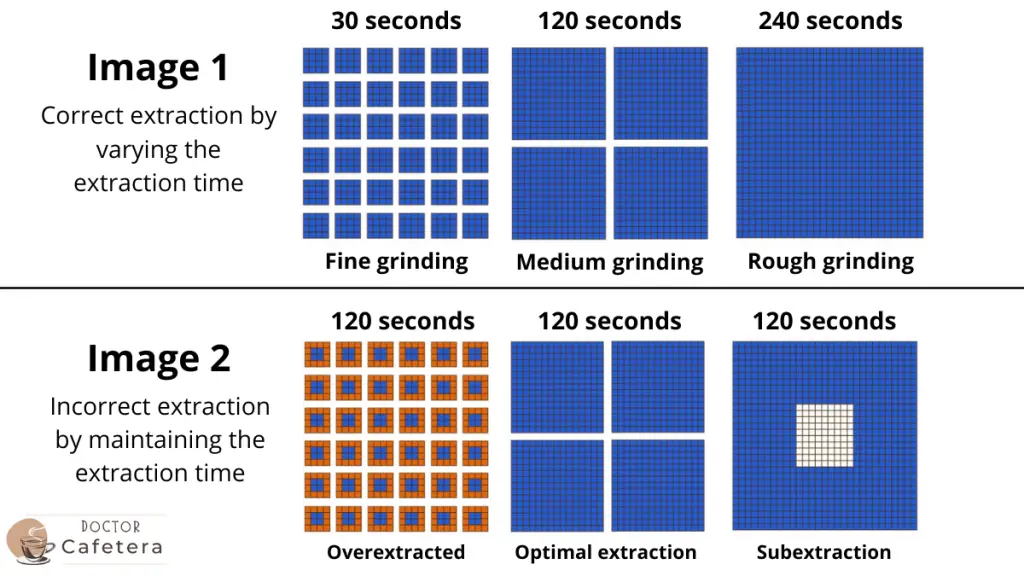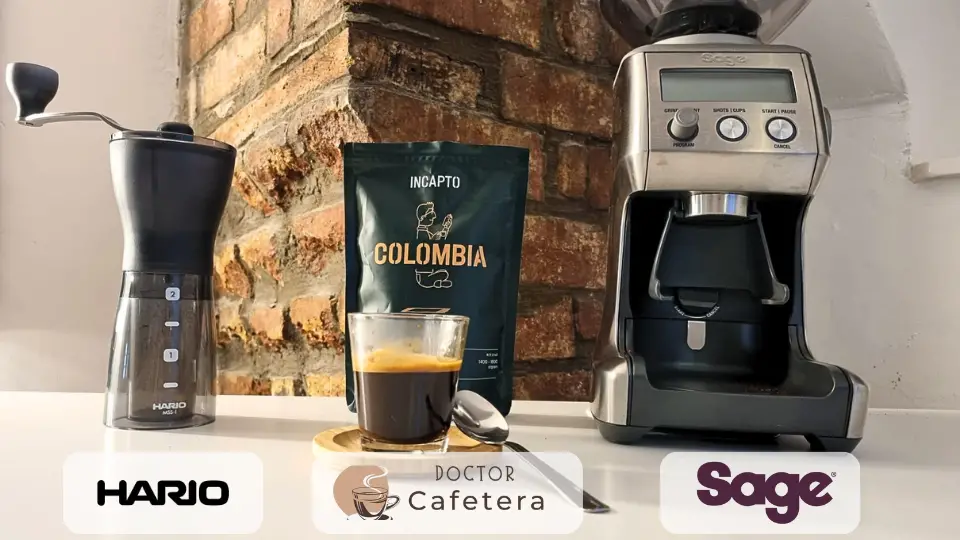Enjoying a cup of exceptionally flavored coffee is not just about selecting good beans; grinding plays a vital role. Errors in grinding, such as improper or inconsistent size, can significantly alter coffee’s taste, aroma, and texture.
Errors in grind size and coffee extraction time
The relationship between coffee grind size and extraction time is crucial, directly impacting the quality of the prepared beverage.
A fine grind and longer contact time with water facilitate the extraction of flavors and aromas during coffee preparation. However, too fine a grind or excessive time can result in undesirable flavors and aromas being extracted.
- Grind too fine: This increases the contact surface area between water and coffee, accelerating extraction. This can result in a bitter, acidic, or overly strong coffee.
- Grind too coarse: This reduces the contact surface area and decreases extraction, resulting in weak, tasteless, and unsatisfying coffee.
In Image 1, it is shown that adjusting the extraction time according to the grind size achieves ideal extraction. In Image 2, it is illustrated that not changing the extraction time for different grind sizes results in poor outcomes in the first and third cases:
Results of each scenario in image 2:
- In the first scenario, over-extraction occurs due to the constant contact of fine grounds with hot water. Each particle is intensely penetrated, which can burn its exterior (represented in orange).
- In the second scenario, optimal extraction is achieved thanks to the medium grind size. Water penetrates slowly into the interior of each particle, extracting the soluble solids at the right moment.
- In the third scenario, under-extraction is observed, as water fails to reach the center of the coarse particles in 120 seconds (represented in white) due to their depth compared to the grain surface.
Grind size according to extraction type
For comprender esto, es importante saber que una micra equivale a una milésima de milímetro:
- French Press and Cold Brew require a coarse grind of 800 and 1000 microns.
- Drip coffee makers and other percolation methods need a medium-coarse grind size, between 500 and 700 microns.
- Italian coffee makers require a medium-fine grind, approximately 400 to 600 microns.
- The proper grind size for espresso should be fine, between 200 and 300 microns.
- The grind for Turkish coffee should be extra fine, below 200 microns.
Note: Without the appropriate instruments, measuring micron grind size is impossible. These references are a starting point for each type of extraction.
The importance of acquiring a proper grinder
A suitable grinder ensures a uniform grind and allows specific adjustments for various brewing methods, such as the French press or espresso, offering control and flexibility in flavor experimentation.
Investing in a good grinder is essential, often surpassing the importance of the coffee maker itself, making the difference between an ordinary cup of coffee and an exceptional experience.
The importance of accurately measuring whole coffee beans
It is crucial to weigh coffee beans accurately before grinding them to ensure the right coffee-to-water ratio. This precision ensures even extraction, essential for each cup’s balanced flavor and consistent quality.
Inaccurate measuring can lead to over-extraction or under-extraction, resulting in coffee that is too strong or weak. Therefore, using a scale to measure beans before grinding is essential in preparing excellent coffee.
External factors affecting coffee grinding
It’s essential to note that ground coffee is much more sensitive than whole beans, and some external factors can affect it:
- Humidity: Coffee beans absorb moisture and become more challenging to grind.
- Temperature: If the environment is too hot, it can cause coffee oils to stick to the grinder blades, affecting the grind quality.
- Altitude: The air is less dense at higher altitudes and can affect grind consistency.
- Air: After grinding, coffee’s aromas and flavors dissipate due to oxidation caused by exposure to air.
- Coffee Quality: Coffee beans from different varieties and origins may have different densities and hardness, affecting grind consistency.
- Storage: Improper storage after grinding can accelerate the loss of aroma and flavor. Therefore, it is essential to store ground coffee in an airtight container and use it as soon as possible to maintain its freshness and flavor.
Note: I recommend buying whole coffee beans and grinding them before use for the best flavor quality. If that’s not possible, pay attention to the type of coffee packaging you purchase.

